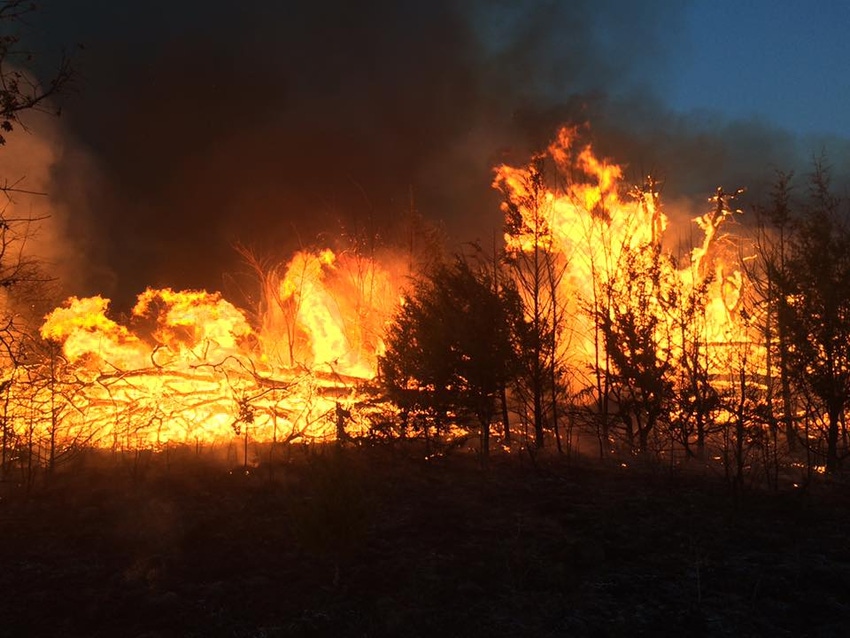President directs emergency grazing for states affected by wildfires
Wildfire-related damages in states expected to grow.

The U.S. Department of Agriculture, acting in response to a directive from President Donald Trump, authorized April 4 emergency grazing on Conservation Reserve Program (CRP) lands located in Kansas, Oklahoma and Texas – the three states most heavily affected by ongoing wildfires, which began on March 6, 2017. USDA acting deputy secretary Michael L. Young issued a memorandum authorizing the emergency grazing of cattle by ranchers, who are facing the ruination of their herds due to a lack of sufficient grazing land. The authorization is pursuant to appropriate restrictions and conservation measures, which can be found in Young’s memorandum.
“The ranchers and farmers in the region have suffered the loss of thousands of heads of cattle and hogs as well as significant property damage,” Trump said in a memo to Young. “This relief will allow those affected to care for their remaining livestock.”
Following the President’s directive, Young issued a memorandum authorizing the emergency grazing and stated, “Ranchers are facing devastating conditions and economic calamity because of these wildfires, and they need some relief, or else they face the total loss of their herds, in many cases. These measures will allow them to salvage what remains of their cattle and return to the important business of feeding Americans and the rest of the world. I commend and thank President Trump for acting decisively in response to this dire situation.”
The USDA action is required to direct the Farm Service Agency to permit the grazing on lands covered by the CRP, which exists to conserve and improve wildlife resources. In this case, the grazing will overlap with the primary nesting season of the lesser prairie chicken. CRP has procedures in place, already developed with the U.S. Fish & Wildlife Service, to permit emergency grazing on protected lands during nesting season. Lesser prairie chicken nesting season runs from March 1 to June 1 in Texas, from April 15 to July 15 in Kansas and from May 1 to July 1 in Oklahoma.
USDA said ranchers and farmers are only now able to begin to estimate losses, since the fires are still burning in some places and access to the lands to survey the damage has been limited. Damages in the states are expected to grow, but USDA said damages are currently estimated as follows:
Kansas
Counties affected include Clark, Comanche, Ellis, Ellsworth, Ford, Hodgeman, Kiowa, Lane, Lincoln, Meade, Ness, Russell and Seward.
An estimated 630,000 acres burned, primarily pasturelands.
The total livestock loss is between 3,000 and 9,000 head of cattle.
Large volumes of hay and feed were destroyed.
The total cost of fencing destroyed exceeds $36 million.
Oklahoma
Counties affected include Beaver, Ellis, Harper, Roger Mills, Woodward and Woods.
About 389,533 acres burned.
The total livestock loss is around 3,000 head of cattle.
The cost of structure loss is about $2 million.
The total cost of fencing destroyed exceeds $22 million.
Texas
Counties affected include Armstrong, Carson, Collingsworth, Donley, Gray, Hansford, Hemphill, Hutchinson, Lipscomb, Moore, Ochiltree, Potter, Randall, Roberts, Sherman and Wheeler.
About 550,000 acres burned, affecting 346 farms and ranches.
The total livestock loss is at least 3,000 cattle and 1,900 swine.
Thousands of miles of fences are expected to be a total loss but so far have been unable to be surveyed.
Craig Uden, president of the National Cattlemen’s Beef Assn., responded to the announcement, noting that Trump, USDA and the governors of Kansas, Texas and Oklahoma "deserve a great deal of credit for moving swiftly to open these lands to grazing so that many of the cattle producers who were dramatically impacted by last month’s wildfires can feed their herds. Those devastating wildfires burned more than 1.5 million acres in Kansas, Oklahoma and Texas and killed an estimated 9,000-18,000 cattle. Those cattle can’t be replaced, but today’s action will help ranchers salvage what remains of their herds.”
About the Author(s)
You May Also Like



